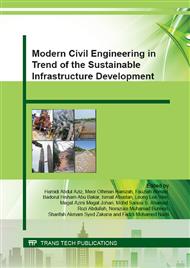[1]
J. Adamstein, Tanker truck blazes closes 60 freeway. Los Angeles Times, Published on December 14, (2011).
Google Scholar
[2]
A.T. Bassam, B.H. Abu Bakar, M.A. Megat Johari, Y.L. Voo, Utilization of ultra-high performance fibre concrete (UHPFC) for rehabilitation – a review. Procedia Engineering, 54 (2013) 525-538.
DOI: 10.1016/j.proeng.2013.03.048
Google Scholar
[3]
A.T. Bassam, B.H. Abu Bakar, M.A. Megat Johari, Y.L. Voo, Evaluation of bond strength between Normal Concrete Substrate and Ultra High Performance Fibre Concrete as a repair material. Procedia Engineering, 54 (2013) 554-563.
DOI: 10.1016/j.proeng.2013.03.050
Google Scholar
[4]
S.D.P. Benson, B. L Karihaloo, CARDIFRC® – Development and mechanical properties. Part I: Development and workability. Magazine of Concrete Research, 57(6) (2005) 347-352.
DOI: 10.1680/macr.2005.57.6.347
Google Scholar
[5]
L. A Bisby, J.F. Chen, S.Q. Li, T.J. Stratford, N. Cueva, K. Crossling, Strengthening fire-damaged concrete by confinement with fibre-reinforced polymer wraps. Engineering Structures, 33 (2011) 3381-3391.
DOI: 10.1016/j.engstruct.2011.07.002
Google Scholar
[6]
E. Brühwiler, E. Denarié, Rehabilitation of concrete structures using Ultra-High Performance Fibre Reinforced Concrete. The Second International Symposium on Ultra High Performance Concrete, Kassel, Germany (2008).
DOI: 10.2749/101686613x13627347100437
Google Scholar
[7]
E. Brühwiler, E. Denarié, & K. Habel, Ultra High Performance Fibre Reinforced Concrete for advance rehabilitation of bridges (2005).
Google Scholar
[8]
Y.N. Chan, G.F. Peng, & M. Anson, Residual strength and pore structure of high-strength concrete and normal strength concrete after exposure to high temperatures. Cement and Concrete Composites, 21 (1999) 23-27.
DOI: 10.1016/s0958-9465(98)00034-1
Google Scholar
[9]
M. Yaqub & C.G. Bailey, Repair of fire damaged circular reinforced concrete columns with FRP composites. Construction and Building Materials, 25 (2011) 359-370.
DOI: 10.1016/j.conbuildmat.2010.06.017
Google Scholar
[10]
E. Denarié, D. Jacomo, F. Nicolas, D. Corves, Rejuvenation of maritime signalisation structures with UHPFRC. Int. Symp. on Ultra-High Performance Fibre-Reinforced Concrete, UHPFRC, Oct. 1-3, (2013).
Google Scholar
[11]
U. Diedrichs, N.P. Hoj, L. Taerwe, Post-fire investigation and repair of fire-damaged concrete structures. International Federation for Structural Concrete (2008).
Google Scholar
[12]
F.A. Farhat, D. Nicolaides, A. Kanellopoulos & B.L. Karihaloo, High performance fibre-reinforced cementitious composite. Engineering Fracture Mechanics, 74 (2007) 151-167.
DOI: 10.1016/j.engfracmech.2006.01.023
Google Scholar
[13]
M. Garlock , I. Paya-Zaforteza, V. Kodur & L. Gu, Fire hazard in bridges: review, assessment and repair strategies. Engineering Structures, 35 (2012) 89-98.
DOI: 10.1016/j.engstruct.2011.11.002
Google Scholar
[14]
K. Habel, E. Denarié, E. Brühwiler, Time dependent behavior of elements combining ultra-high performance fiber reinforced concretes (UHPFRC) and reinforced concrete, Materials and Structures, 39(5) (2006) pp.557-569.
DOI: 10.1007/s11527-005-9045-0
Google Scholar
[15]
R.H. Haddad, N. Al-Mekhlafy, A.M. Ashteyat, Repair of heat-damaged reinforced concrete slabs using fibrous composite materials. Construction and Building Materials, 25 (2011) 1213-1221.
DOI: 10.1016/j.conbuildmat.2010.09.033
Google Scholar
[16]
M. Jesse, C. Marshall, Overpass near San Francisco collapses after fire. New York Times, Published April 29, (2007).
Google Scholar
[17]
B.L. Karihaloo, Cardifrc-Development to Industry. RILEM, HPFRCC 6 (2012) 397-404.
Google Scholar
[18]
P. Maça, R. Sovjàk, P. Konvalinka, Mix design of UHPFRC and its response to projectile impact. International Journal of Impact Engineering, 63 (2014) 158-163.
DOI: 10.1016/j.ijimpeng.2013.08.003
Google Scholar
[19]
P. Richard, M. Cheyrezy, Composition of reactive powder concretes. Cement and Concrete Research, 25(7) (1995) 1501-1511.
DOI: 10.1016/0008-8846(95)00144-2
Google Scholar
[21]
Y. Uchida, J. Niwa, Y. Tanaka, M. Katagiri, G. Fishcher, V. Li, Recommendations for design and construction of ultra high strength fibre reinforced concrete structures, by Concrete Committee of Japan Society of Civil Engineers (JSCE) (2006).
DOI: 10.3151/coj1975.43.3_3
Google Scholar
[22]
Y.L. Voo, S.J. Foster, Characteristics of ultra-high performance ductile, concrete and its impact on sustainable construction. The IES Journal Part A: Civil and Structural Engineering, 3(3) (2010) 168-187.
DOI: 10.1080/19373260.2010.492588
Google Scholar
[23]
G. De-Lange. Structural repair of fire damaged concrete. Concrete International 1980; 2(9): 27–9.
Google Scholar
[24]
R. Yu, P. Spiesz, H.J.H. Brouwers, Development of Ultra-High Performance Fibre Reinforced Concrete. Construction and Building Materials, 79 (2015) 273-282.
DOI: 10.1016/j.conbuildmat.2015.01.050
Google Scholar
[25]
R. Wheatley, N. Gibbin, M. de Melo, M. Gonzales-Quesada, K. Harwood, Assessment and repair of a fire-damaged pre-stressed concrete bridge. Structural Engineering International, 24(3) (2014) 408-413.
DOI: 10.2749/101686614x13844300210272
Google Scholar
[26]
S. L Yang, S.G. Millard, M.N. Soutsos, S.J. Barnett, T.T. Le, Influence of aggregate and curing regime on the mechanical. Construction and Building Materials, 23 (2009) 2291-2298.
DOI: 10.1016/j.conbuildmat.2008.11.012
Google Scholar
[27]
J.P. Charron, E. Denarie, E. Bruhwiler, Permeability of ultra high performance fiber reinforced concretes (UHPFRC) under high stresses. Materials and Structures, 40 (2007) 269-277.
DOI: 10.1617/s11527-006-9105-0
Google Scholar
[28]
R. Torrent, L. Fernandez Luco. Non-destructive Evaluation of the penetrability and thickness of the concrete cover, State of the Art Report, RILEM TC 189-NEC (2007).
Google Scholar
[29]
C.W. Aldea, S.P. Shah, A.F. Karr Permeability of cracked concrete. Materials and Structures, 32(219) (1999) 370–376.
DOI: 10.1007/bf02479629
Google Scholar
[30]
R.H. Haddad, R. Al-Rousan, A. Almasry. Bond-slip behavior between carbon fiber reinforced polymer sheets and heat-damaged concrete. Composites: Part B 45 (2013) 1049-1060.
DOI: 10.1016/j.compositesb.2012.09.010
Google Scholar
[31]
A. Leonardi, A. Meda, Z. Rinaldi. Fire-damaged R/C members repair with High-Performance Fibre-Reinforced Jacket. Strain, 47(Suppl. 2) (2011) 28-35.
DOI: 10.1111/j.1475-1305.2010.00731.x
Google Scholar


